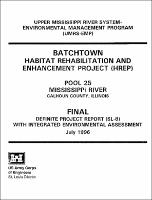Please use this identifier to cite or link to this item:
https://hdl.handle.net/11681/36694| Title: | Upper Mississippi River System-Environmental Management Program Definite Project Report (SL-8) with Integrated Environmental Assessment : Batchtown Habitat Rehabilitation and Enhancement Project (HREP), Pool 25, Mississippi River, Calhoun County, Illinois |
| Authors: | United States. Army. Corps of Engineers. St. Louis District |
| Keywords: | Restoration ecology Environmental protection Environmental management Wetlands Mississippi River |
| Publisher: | United States. Army. Corps of Engineers. St. Louis District. |
| Abstract: | The Batchtown Habitat Rehabilitation and Enhancement Project is part of the Upper Mississippi River System-Environmental Management Program. The project is located on the Illinois side of the Mississippi River, in Pool 25, just upstream of Lock & Dam No. 25. The project area is contained within the Mark Twain National Wildlife Refuge, and is managed by both the U.S. Fish and Wildlife Service and the Illinois Department of Natural Resources (formerly the Illinois Department of Conservation). The 3,327-acre project consists of approximately 989 acres of forested wetland, 224 acres of cropland, 13 acres of moist soil, 1,172 acres of non-forested wetland and 929 acres of water. The Batchtown area was once a prime habitat site for large numbers of migrating waterfowl. However, its habitat has been severely degraded due to siltation received from the Mississippi River and from runoff from a fairly large and steeply-sloped local upland watershed system. Additionally, necessary releases of water from Pool 25 cause harmful water level fluctuations in the project area. The project's management goal is to restore and maintain riverine habitat diversity to benefit fish, wildlife and freshwater mussels. Specific objectives of this project are to: increase diversity of wetland types within the project area, create a water-level management capability that is independent of water levels in Pool 25, reduce the rate of siltation throughout the project area, improve habitat quality and quantity of bottomland forest within the project area, improve spawning habitat for riverine fishes, improve overwintering habitat for fish in side channels and backwaters, improve side channel habitat by preventing river-borne sediment from filling the side channels, and ensure adequate long-term water flow over the freshwater mussel beds. The measures identified and evaluated to address the problems include: berms for interior water control and to prevent frequent flooding; gated water control structures; pump stations; fish-passage structures; dredging of side channels, lakes, and backwaters; dredge spoil for island construction; dike construction; bottomland forest habitat improvements; off-bankline revetment; upland sediment control measures; and the acquisition of wildlife lands for wetland restoration and protection. This report documents the formulation of specific management measures and evaluates them as to their acceptability to the US Fish and Wildlife Service and the Illinois Department of Natural Resources, and evaluates the measures as to their engineering effectiveness, their ability to meet the project objectives, and as to their cost effectiveness. The recommended plan consists of variations and improvements made to a Concept Plan C to more address ecosystem objectives. The attached schematic shows the general locations of recommended measures. Habitat enhancements from the project are estimated to provide a net gain of 903 average annual habitat units (AAHUs) for wildlife and 746 AAHUs for fishes, and 56 AAHUs for mussels. Fully funded project costs including planning study costs, preparation of plans and specifications, construction costs, and construction management costs are estimated to be about $8,148,000, and annual operation, maintenance and rehabilitation costs are about $83,000. |
| Description: | Definite Project Report with Integrated Environmental Assessment |
| Rights: | Approved for Public Release; Distribution is Unlimited |
| URI: | https://hdl.handle.net/11681/36694 |
| Appears in Collections: | Environmental Documents |
Files in This Item:
| File | Description | Size | Format | |
|---|---|---|---|---|
| BatchtownDPR.pdf | 43 MB | Adobe PDF |  View/Open |